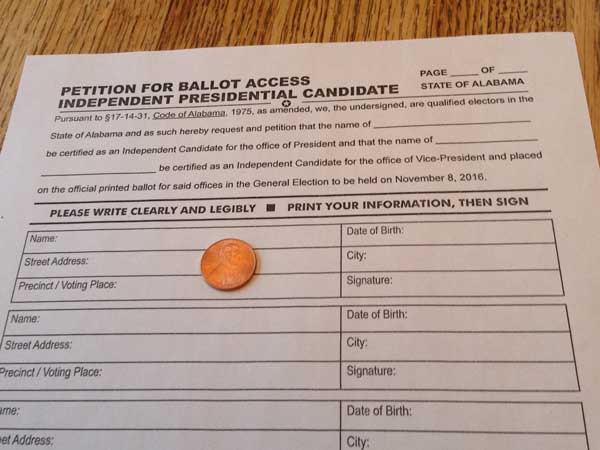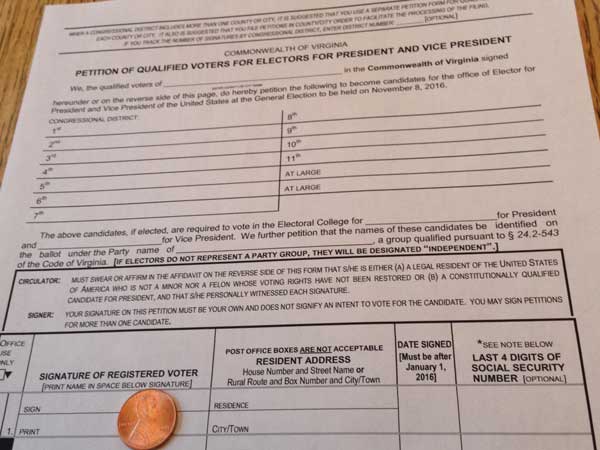
Ballot access for independent candidates to get on state ballots in time for the next national (or state or local) election is backwards. The rules are completely different than running as a Democrat or Republican. The rules and the convoluted details related to those rules (usually written in dense and hard to understand government speak) are also totally different (and not particularly logical) in every state.
For example, I can qualify as an independent Presidential candidate by collecting signatures of registered voters – I need 5,000 such signatures in Ohio and oddly I need 40,047 signatures to qualify in Oklahoma. I could also get on the November 8th ballot as the Presidential candidate of a third party that is already ballot-certified. There are many and I am seeking the nomination of several small ballot-certified parties with platforms that I can support. The lists of certified parties in each state are nearly impossible to find and we now just assume that state lists of ballot-certified parties are out of date. I could also get on the November 8th ballot by helping to start an independent 3rd party requiring, for example, 89,366 signatures in North Carolina or 1,000 signatures in Louisiana.
Ballot Access For Independents Beyond Signature Requirements
Those are just the signature requirements. There are different rules in every state about the paperwork to be submitted before or after the signatures are collected (or at the same time or at a soon-to-be-determined time). The paperwork may be called a “Statement of Intention” or a “Statement of Candidacy or a “Declaration of Intent” or something else. Or, I just file a copy of the signature petition to be circulated (assuming I could find the current one – which is not as easy as it sounds) with the top section filled out.
Oh, that top section! Seems like the fewer the signatures needed to get on the ballot the more (and stranger) the information required before signatures can even be collected. In many states, I must name my Vice Presidential running mate to even begin collecting signatures. This is clearly an extra challenge for independent candidates: Republican and Democrat candidates can name their running mates close to the summertime national conventions before the election.
I knew that many states would require me to name my running mate early. Several independent Presidential candidates have named a “stand-in” running mate to pursue ballot access. In 1980, John Anderson named 81-year old Milton S. Eisenhower as his running mate; in 1992, Ross Perot named retired Vice Admiral James B. Stockdale as his ”interim” running mate. I chose this “interim” route. In February of this year, Kathleen Monahan – a strategic planner with expertise in homeland defense, homeland security, border control and immigration – graciously agreed to be my “stand in” running mate. We shared many years working on the White House Partnership to Reinvent Government. We can speak in shorthand about cutting red tape, translating government speak into plain language, or gutting those awful performance measures that have led nearly all our federal agencies down the wrong path. This pairing was strong in many ways and I am forever grateful to Kathy for supporting me in this way.
The top section of the signature form in many states takes us to the topic of Presidential Electors! You may remember from high school American History that the Constitution of the United States says Electors vote for the President and Vice President. For 2016, each Governor will convene their Electoral College in their respective state capitol on December 19. This is the first Monday after the second Wednesday in December – a schedule set so our founding fathers and early political leaders had time to ride their horse and buggy to capitol cities! My Electors vote for me at the Electoral College – this can be straightforward or controversial – and all remains to be seen in this contentious election cycle.

Independent candidates for President must generally identify their Presidential Electors when signature petitions are submitted for validation. More than a few states require me to name my Presidential Electors before I can begin to collect signatures! I have been talking with many supporters about the Electoral College. I want regular Americans to go to the Electoral College – to demonstrate that democracy is more than a photo opportunity for the Republican and Democrat party leaders that represent the inability of our government to solve national problems. I am honored that so many supporters are so delighted to sign on as Presidential Electors for their state..
What else goes on that top section of the signature petition form? Something called the “committee to represent the candidate” or a variation of this wording seems to show itself on way too many signature petitions. This is poorly defined though I think it means that if I am incapacitated between the time the ballots are printed with my name on them and November 8th – the date of the 2016 Presidential election – the “committee” names my replacement.
This article describing February 15 to March 5, 2016 is subtitled “Laughing Through the Tears” – as in laughing until tears rolled down our cheeks! First, however, there was the groaning about how to submit the completed signatures.
Ballot Access For Independents – Where do I submit my forms?
Another convoluted piece of the ballot access puzzle – and inconsistent across all states – is exactly when and where candidates deliver the packages of signed petitions. Depending on whether that state allows 5 or 10 or 11 or 15 or 20 or just one single signature per page, we are talking hundreds or thousands of pages of signatures with different rules about how pages are organized and numbered. Different rules also apply to whether the signatures are delivered for verification to town clerks or county clerks or the Secretary of State’s office in the capitol building or the Elections Office in another building.
The mild laughter started with North Carolina – the 89,366 signatures (plus another 10,000 to compensate for those tossed out by validation clerks) would be collected on pages organized by county and then delivered to counties. In most states, signatures are organized by county then bundled all together and delivered to the Secretary of State or Elections Commission. In North Carolina, signatures are collected on petitions with the county name at the top of the page and then the county pages are submitted to the County Board of Elections in each of North Carolina’s 100 counties. This means campaign staff would personally go to each of 100 counties one at a time so the county could certify signatures and then bundle all the pages to be submitted to the State Board of Election by June 9 (a particularly early deadline)! We agreed: “Delete North Carolina from signature collecting and move the state to the write-in category.”
The state that then brought down the house laughter-wise was Virginia – not so much that the signature petition forms had to be printed out and filled out double sided. Okay, so single sided petition forms would not be accepted. And not even that Virginia required me to name my 11 Presidential Electors by Congressional District on the top section of the signature form. Yes, one Presidential Elector from each Congressional District (and two at-large Electors) before any signatures could be collected. The deep groaning and random laughter began when we read that each Elector would have to sign and have notarized a Statement of Qualification and sign an Oath of Allegiance to the Constitution.
On the plus side, Virginia actually has the current forms on the Elections website. In many states, you have to call in (if you can figure out where) or physically visit the right office (good luck with that) or even (no kidding) create your own forms that may or may not be acceptable (judgment rendered when you make the physical visit to the correct office).
The laughter (yes it was getting late) was triggered by the ridiculous amount of time we spent deciding whether the 8½ by 11-inch Virginia signature petition was too small for real people to sign (it is) and then how exactly to print out the 11 by 14-inch petition. Somehow the downloaded 11×14 page didn’t print with columns and margins in the correct place. With growing howls of laughter – and tears running down my cheeks – we tried and tried then gave up for the night.
The next day, campaign staff went to two different copy and office support centers to first print out the wrong form (the signature petition for the Presidential Primary not for independent Presidential candidates to get on the November 8th ballot) and then find that even the staff of a high-end office support center could not get the columns and margins to line up and allow enough space for anyone to actually sign the petition. The light-heartedness carried through the day – just mentioning the Commonwealth would bring on groans and laughter.
True Ballot Access For Independents is Missing
So weeks 7 through 9 was dedicated to ballot access in an office setting; weeks 10 through 12 would be dedicated to ballot access in a 3-week 6,000 miles tear from state capitol to state capitol – the topic of my next Road to the White House journal entry. Now, whenever you hear a potential candidate declare, “I have decided not to run as an independent” you can smile – even laugh – and guess at the real reasons!

Leave a Reply